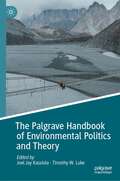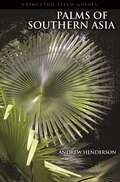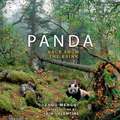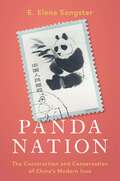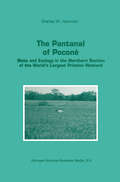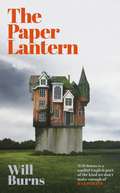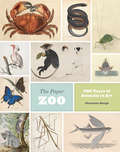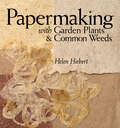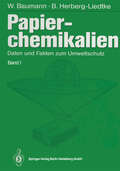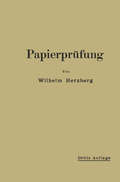- Table View
- List View
The Palgrave Handbook of Environmental Labour Studies
by Nora Räthzel Dimitris Stevis David UzzellIn this comprehensive Handbook, scholars from across the globe explore the relationships between workers and nature in the context of the environmental crises. They provide an invaluable overview of a fast-growing research field that bridges the social and natural sciences. Chapters provide detailed perspectives of environmental labour studies, environmental struggles of workers, indigenous peoples, farmers and commoners in the Global South and North. The relations within and between organisations that hinder or promote environmental strategies are analysed, including the relations between workers and environmental organisations, NGOs, feminist and community movements.
The Palgrave Handbook of Environmental Politics and Theory (Environmental Politics and Theory)
by Joel Jay Kassiola Timothy W. LukeThis Handbook aims to provide a unique and convenient one-volume reference work, exhibiting the latest interdisciplinary explorations in this urgently burgeoning field of intellectual and practical importance. Due to its immense range and diversity, environmental politics and theory necessarily encompasses: empirical, normative, policy, political, organizational, and activist discussions unfolding across many disciplines. It is a challenge for its practitioners, let alone newcomers, to keep informed about the ongoing developments in this fast-changing area of study and to comprehend all of their implications. Through the planned volume’s extensive scope of contributions emphasizing environmental policy issues, normative prescriptions, and implementation strategies, the next generation of thinkers and activists will have very useful profiles of the theories, concepts, organizations, and movements central to environmental politics and theory. It is the editors’ aspiration that this volume will become a go-to resource on the myriad perspectives relevant to studying and improving the environment for advanced researchers as well as an introduction to new students seeking to understand the basic foundations and recommended resolutions to many of our environmental challenges. Environmental politics is more than theory alone, so the Handbook also considers theory-action connections by highlighting the past and current: thinkers, activists, social organizations, and movements that have worked to guide contemporary societies toward a more environmentally sustainable and just global order. Chapter “Eco-Anxiety and the Responses of Ecological Citizenship and Mindfulness” is available open access under a Creative Commons Attribution 4.0 International License via link.springer.com.
The Palgrave Handbook of Environmental Restorative Justice
by Brunilda Pali Miranda Forsyth Felicity TepperThis handbook explores the dynamic new field of Environmental Restorative Justice. Authors from diverse disciplines discuss how principles and practices of restorative justice can be used to address the threats and harms facing the environment today. The book covers a wide variety of subjects, from theoretical discussions about how to incorporate the voice of future generations, nature, and more-than-human animals and plants in processes of justice and repair, through to detailed descriptions of actual practices of Environmental Restorative Justice. The case studies explored in the volume are situated in a wide range of countries and in the context of varied forms of environmental harm – from small local pollution incidents, to endemic ongoing issues such as wildlife poaching, to cataclysmic environmental catastrophes resulting in cascades of harm to entire ecosystems. Throughout, it reveals how the relational and caring character of a restorative ethos can be conducive to finding solutions to problems through sharing stories, listening, healing, and holding people and organisations accountable for prevention and repairing of harm. It speaks to scholars in Criminology, Sociology, Law, and Environmental Justice and to practitioners, policy-makers, think-tanks and activists interested in the environment.
The Palgrave Handbook of Local Governance in Contemporary China
by Sujian Guo Jianxing YuThis Handbook provides a comprehensive overview of local governance in China, and offers original analysis of key factors underpinning trends in this field drawing on the expertise of scholars both inside and outside China. It explores and analyzes the dynamic interaction and collaboration among multiple governmental and non-governmental actors and social sectors with an interest in the conduct of public affairs to address horizontal challenges faced by the local government, society, economy, and civil community and considers key issues such as governance in urban and rural areas, the impact of technology on governance and related issues of education, healthcare, environment and energy.As the result of a global and interdisciplinary collaboration of leading experts, this Handbook offers a cutting-edge insight into the characteristics, challenges and trends of local governance and emphasizes the promotion of good governance and democratic development in China.
The Palgrave Handbook of Managing Fossil Fuels and Energy Transitions
by Geoffrey Wood Keith BakerThis Handbook is the first volume to comprehensively analyse and problem-solve how to manage the decline of fossil fuels as the world tackles climate change and shifts towards a low-carbon energy transition. The overall findings are straight-forward and unsurprising: although fossil fuels have powered the industrialisation of many nations and improved the lives of hundreds of millions of people, another century dominated by fossil fuels would be disastrous. Fossil fuels and associated greenhouse gas emissions must be reduced to a level that avoids rising temperatures and rising risks in support of a just and sustainable energy transition. Divided into four sections and 25 contributions from global leading experts, the chapters span a wide range of energy technologies and sources including fossil fuels, carbon mitigation options, renewables, low carbon energy, energy storage, electric vehicles and energy sectors (electricity, heat and transport). They cover varied legal jurisdictions and multiple governance approaches encompassing multi- and inter-disciplinary technological, environmental, social, economic, political, legal and policy perspectives with timely case studies from Africa, Asia, Australia, Europe, North America, South America and the Pacific. Providing an insightful contribution to the literature and a much-needed synthesis of the field as a whole, this book will have great appeal to decision makers, practitioners, students and scholars in the field of energy transition studies seeking a comprehensive understanding of the opportunities and challenges in managing the decline of fossil fuels.
The Palgrave Handbook of Natural Gas and Global Energy Transitions
by Damilola S. Olawuyi Eduardo G. PereiraThe Palgrave Handbook of Natural Gas and Global Energy Transitions provides an in-depth and authoritative examination of the transformative implications of the ongoing global energy transitions for natural gas markets across the world.With case studies from Africa, Asia, Europe, North America, Latin America, South America, Australia, and the Middle East, the volume introduces readers to the latest legal, policy, technological, and fiscal innovations in natural gas markets in response to ongoing global energy transitions. It outlines the risk mitigation strategies and contractual techniques — focusing on resilience planning, low-carbon business models, green procurement, climate-smart infrastructure development, accountability, gender justice, and other sustainability safeguards — that are required to maximize the full value of natural gas as a catalyst for a just and equitable energy transition and for energy security across the world.Written in an accessible style, this book outlines the guiding principles for a responsible and low-carbon approach to the design, financing, and implementation of natural gas development and commercialization. It is an indispensable text and reference work for students, scholars, practitioners, and stakeholders in natural gas, energy, infrastructure, and environmental investments and projects.
Palm Oil: The Grease of Empire (Vagabonds)
by Max HaivenIt’s in our food, our cosmetics, our fuel and our bodies. Palm oil, found in half of supermarket products, has shaped our world. Max Haiven uncovers how the gears of capitalism are literally and metaphorically lubricated by this ubiquitous elixir. From its origins in West Africa to today’s Southeast Asian palm oil superpowers, Haiven’s sweeping, experimental narrative takes us on a global journey that includes looted treasures, the American system of mass incarceration, the history of modern art and the industrialisation of war. Beyond simply calling for more consumer boycotts, he argues for recognising in palm oil humanity’s profound potential to shape our world beyond racial capitalism and neo-colonial dispossession. One part history, one part dream, one part theory, one part montage, this kaleidoscopic and urgent book asks us to recognise the past in the present and to seize the power to make a better world.
Palm Oil: The Grease of Empire (Vagabonds)
by Max HaivenIt’s in our food, our cosmetics, our fuel and our bodies. Palm oil, found in half of supermarket products, has shaped our world. Max Haiven uncovers how the gears of capitalism are literally and metaphorically lubricated by this ubiquitous elixir. From its origins in West Africa to today’s Southeast Asian palm oil superpowers, Haiven’s sweeping, experimental narrative takes us on a global journey that includes looted treasures, the American system of mass incarceration, the history of modern art and the industrialisation of war. Beyond simply calling for more consumer boycotts, he argues for recognising in palm oil humanity’s profound potential to shape our world beyond racial capitalism and neo-colonial dispossession. One part history, one part dream, one part theory, one part montage, this kaleidoscopic and urgent book asks us to recognise the past in the present and to seize the power to make a better world.
Palms of Southern Asia
by Andrew HendersonSouthern Asia is a vast and ecologically diverse region that extends from the deserts of Afghanistan to the rainforests of Thailand, and is home to a marvelously rich palm flora. Palms of Southern Asia is the only complete field guide to the 43 genera and 352 species of palms and rattans that occur in Afghanistan, Bangladesh, Bhutan, Cambodia, China, India, Japan, Laos, Myanmar, Nepal, Pakistan, Sri Lanka, Taiwan, Thailand, and Vietnam. This attractive guide's handsome illustrations and succinct, authoritative, and jargon-free text make identification easy. Each species account includes the correct scientific and common names, and fully describes morphology, habitat, and uses. Featuring a distribution map for most species and 256 full-color photographs, this is also the only field guide to cover the extremely diverse palm flora of Vietnam, and the first to offer a taxonomic overview of the rattan species of Southern Asia. Palms of Southern Asia is a book of major importance for botanists and an invaluable aid for naturalists and conservationists, and it's the perfect field guide for ecotourists traveling in the region. Covers all 352 naturally occurring palms in Southern Asia Features full-color photographs of 256 species, many never before illustrated Includes a distribution map for most species Provides the first taxonomic overview of the rattans of Southern Asia
Palms of Southern Asia
by Andrew HendersonSouthern Asia is a vast and ecologically diverse region that extends from the deserts of Afghanistan to the rainforests of Thailand, and is home to a marvelously rich palm flora. Palms of Southern Asia is the only complete field guide to the 43 genera and 352 species of palms and rattans that occur in Afghanistan, Bangladesh, Bhutan, Cambodia, China, India, Japan, Laos, Myanmar, Nepal, Pakistan, Sri Lanka, Taiwan, Thailand, and Vietnam. This attractive guide's handsome illustrations and succinct, authoritative, and jargon-free text make identification easy. Each species account includes the correct scientific and common names, and fully describes morphology, habitat, and uses. Featuring a distribution map for most species and 256 full-color photographs, this is also the only field guide to cover the extremely diverse palm flora of Vietnam, and the first to offer a taxonomic overview of the rattan species of Southern Asia. Palms of Southern Asia is a book of major importance for botanists and an invaluable aid for naturalists and conservationists, and it's the perfect field guide for ecotourists traveling in the region. Covers all 352 naturally occurring palms in Southern Asia Features full-color photographs of 256 species, many never before illustrated Includes a distribution map for most species Provides the first taxonomic overview of the rattans of Southern Asia
Panda: Back From The Brink
by Zhou MengqiA celebration of the iconic giant panda (includes donation to the pandas in the care of Edinburgh Zoo). Despite becoming a symbol of wildlife conservation, having narrowly avoided extinction, there are fewer than 2,000 giant pandas alive today. This spectacular celebration of our best-loved bear combines the expertise of the foremost panda conservationists with an extraordinary collection of photographs, previously unseen in the UK. Catch a rare glimpse of this shy creature at home in the high mountain forests of Sichuan, and peek inside the nursery at the Wolong research institution where efforts to save the panda have been bearing fruit.
Panda Nation: The Construction and Conservation of China's Modern Icon
by E. Elena SongsterA logo on products ranging from chopsticks and toilet paper to cell phones and automobiles, the panda is one of the most ubiquitous images in China and throughout the world. Yet the panda holds little notable historical significance in China. Although it has existed in the territory of present-day China since the Pliocene epoch, its widespread popularity there is not only recent, but almost sudden. In Panda Nation, E. Elena Songster links the emergence of the giant panda as a national symbol to the development of nature protection in the People's Republic of China. The panda's transformation into a national treasure exemplifies China's efforts in the mid-twentieth century to distinguish itself as a nation through government-directed science and popular nationalism. The story of the panda's iconic rise offers a striking reflection of China's recent and dramatic ascent as a nation in global status.
Panda Nation: The Construction and Conservation of China's Modern Icon
by E. Elena SongsterA logo on products ranging from chopsticks and toilet paper to cell phones and automobiles, the panda is one of the most ubiquitous images in China and throughout the world. Yet the panda holds little notable historical significance in China. Although it has existed in the territory of present-day China since the Pliocene epoch, its widespread popularity there is not only recent, but almost sudden. In Panda Nation, E. Elena Songster links the emergence of the giant panda as a national symbol to the development of nature protection in the People's Republic of China. The panda's transformation into a national treasure exemplifies China's efforts in the mid-twentieth century to distinguish itself as a nation through government-directed science and popular nationalism. The story of the panda's iconic rise offers a striking reflection of China's recent and dramatic ascent as a nation in global status.
The Pantanal of Poconé: Biota and Ecology in the Northern Section of the World’s Largest Pristine Wetland (Monographiae Biologicae #77)
by Charles W. HeckmanThere are many famous wetlands in the world that have been deemed important for the homeostasis ofthe biosphere and accorded some form ofprotected status in view of the richness of their flora and fauna. T}1e Pantanal, located almost directly in the center ofthe South American continent, is among the largest such wetlands in the world. It is, in fact, the largest wetland that is still in a nearly natural state and has not been extensively modified by man for agriculture. The extent of the region covered by flood waters at the end of each rainy season varies from year to year, sometimes considerably, so estimates of the exact area it occupies have varied enormously. The size of the 2 2 Pantanal has been reported to be between 80,000 km (Bonetto, 1975) and 250,000 km (Tundisi and Matsumura-Tundisi, 1985). The most co~on1y accepted estimates at the present time are approximately 130,000 to 140,000 km , supported by estimates made from Nimbus-7 satellite observations (Hamilton et al. , 1996). However, Por (1995) suggested that the area extending into Bolivia and Paraguay has not been satisfactorily 2 surveyed, leading him to accept the figure of 200,000 km as the area of the entire Pantanal, ineluding all of its extensions. The main reason for the year to year variation in the extent of the flooding is the considerable difference in timing of the rainfall on the watershed.
The Paper Florist: Create and display stunning paper flowers
by Suzi MclaughlinPaper flowers are not only beautiful, but also incredibly versatile. They can be used to create everything from simple home decorations and gorgeous gifts to unique centrepieces and decorative one-off bouquets, all made from the most basic and inexpensive materials. Suzi McLaughlin's step-by-step tutorials cover a beautiful array of flowers including bluebells, peonies, poppies, cherry blossom and more, and will teach everything you need to know. Make delicate lifelike flowers, or let your imagination run wild and use Suzi's techniques to create playful hybrids. Adorn your home with colour and style with just a few simple steps.The flowers are accompanied by templates for every shape used in the book, as well as instructions on how to display your creations to their full potential. Whether you want to make a gloriously blousy bouquet, a bejewelled cherry blossom branch or an impressive floral centrepiece, this book is sure to delight and inspire.
The Paper Lantern
by Will Burns'Will Burns is a soulful English poet of the kind we don't make enough of' MAX PORTER'Hugely affecting and timely' LUKE TURNER'A boldly struck chord, one that contains many of the dissonances, but also the harmonies, found in England today' CHRIS POWERIn THE PAPER LANTERN, a single speaker charts and interrogates the shifts in mood and understanding that have defined a surreal, transformative period in both his own history and that of the surrounding area. Set in a shuttered pub - The Paper Lantern - in a village in the very middle of the country adjacent to the Chequers estate, the narrator embarks on a series of walks in the Chiltern Hills, which become the landscape for evocations of a past scarred with trauma and a present lacking compass. From local raves in secret valleys and the history of landmarks such as Halton House, to the fallout of the lockdown period, climate change and capitalism, THE PAPER LANTERN creates a tangible, lived-in, complicated rendering of a place.
The Paper Zoo: 500 Years of Animals in Art
by Charlotte SleighAs children, our first encounters with the world’s animals do not arise during expeditions through faraway jungles or on perilous mountain treks. Instead, we meet these creatures between the pages of a book, on the floor of an obliging library. Down through the centuries, illustrated books have served as our paper zoos, both documenting the world’s extraordinary wildlife in exquisite detail and revealing, in hindsight, how our relationship to and understanding of these animals have evolved over time. In this stunning book, historian of science Charlotte Sleigh draws on the ultimate bibliophile’s menagerie—the collections of the British Library—to present a lavishly illustrated homage to this historical collaboration between art and science. Gathering together a breathtaking range of nature illustrations from manuscripts, prints, drawings, and rare printed books from across the world, Sleigh brings us face to face (or face to tentacle) with images of butterflies, beetles, and spiders, of shells, fish, and coral polyps. Organized into four themed sections—exotic, native, domestic, and paradoxical—the images introduce us to some of the world’s most renowned natural history illustrators, from John James Audubon to Mark Catesby and Ernst Haeckel, as well as to lesser-known artists. In her accompanying text, Sleigh traces the story of the art of natural history from the Renaissance through the great age of exploration and into the nineteenth century, offering insight into the changing connections between the natural and human worlds. But the story does not end there. From caterpillars to crabs, langurs to dugongs, stick insects to Old English pigs; from the sinuous tail feathers of birds of paradise to the lime-green wings of New Zealand’s enormous flightless parrot, the kakapo; from the crenellated plates of a tortoise’s shell to imagined likenesses of unicorns, mermaids, and dinosaurs, the story continues in this book. It is a Paper Zoo for all time.
The Paper Zoo: 500 Years of Animals in Art
by Charlotte SleighAs children, our first encounters with the world’s animals do not arise during expeditions through faraway jungles or on perilous mountain treks. Instead, we meet these creatures between the pages of a book, on the floor of an obliging library. Down through the centuries, illustrated books have served as our paper zoos, both documenting the world’s extraordinary wildlife in exquisite detail and revealing, in hindsight, how our relationship to and understanding of these animals have evolved over time. In this stunning book, historian of science Charlotte Sleigh draws on the ultimate bibliophile’s menagerie—the collections of the British Library—to present a lavishly illustrated homage to this historical collaboration between art and science. Gathering together a breathtaking range of nature illustrations from manuscripts, prints, drawings, and rare printed books from across the world, Sleigh brings us face to face (or face to tentacle) with images of butterflies, beetles, and spiders, of shells, fish, and coral polyps. Organized into four themed sections—exotic, native, domestic, and paradoxical—the images introduce us to some of the world’s most renowned natural history illustrators, from John James Audubon to Mark Catesby and Ernst Haeckel, as well as to lesser-known artists. In her accompanying text, Sleigh traces the story of the art of natural history from the Renaissance through the great age of exploration and into the nineteenth century, offering insight into the changing connections between the natural and human worlds. But the story does not end there. From caterpillars to crabs, langurs to dugongs, stick insects to Old English pigs; from the sinuous tail feathers of birds of paradise to the lime-green wings of New Zealand’s enormous flightless parrot, the kakapo; from the crenellated plates of a tortoise’s shell to imagined likenesses of unicorns, mermaids, and dinosaurs, the story continues in this book. It is a Paper Zoo for all time.
Papermaking with Garden Plants & Common Weeds
by Helen HiebertMake exquisite papers right in your own kitchen. With a few pieces of basic equipment and a small harvest of backyard weeds, you can easily create stunningly original handcrafted papers. Helen Heibert&’s illustrated step-by-step instructions show you how easy it is to blend and shape a variety of organic fibers into professional stationery, specialty books, and personalized gifts. You&’ll soon be creatively integrating plant stalks, bark, flower petals, pine needles, and more to add unique colors and textures to your paper creations. This publication conforms to the EPUB Accessibility specification at WCAG 2.0 Level AA.
Papierprüfung: Eine Anleitung z. Untersuchen von Papier; Mit 86 Textfig. u. 17 Taf
by Wilhelm HerzbergParadigms and Theories Influencing Policies in the South African and International Water Sectors: PULSE³, A Framework for Policy Analysis
by Richard MeissnerThis book presents a new way of looking at and analyzing policies, programs and/or plans in which research scientists have used their knowledge to develop mechanisms such as South Africa's National Water Resource Strategy, Second Edition; Australian and South African climate change adaptation strategies for government entities and the UNDP's Water and Ocean Governance focus area. It critically assesses how science can be used in the service of society and how researchers and practitioners can bridge the gaps that arise as a result of incomplete thinking. Presenting a bird’s-eye view of how thinking and understanding operate in the policy context, it offers a valuable contribution to fields of inquiry such as research methods, comparative analyses, political science, international relations and the natural and social sciences in general. This book fills a market gap, providing real-world solutions to the practical application of science, paradigms and theories.
Paradise Found: Nature in America at the Time of Discovery
by Steve NichollsThe first Europeans to set foot on North America stood in awe of the natural abundance before them. The skies were filled with birds, seas and rivers teemed with fish, and the forests and grasslands were a hunter’s dream, with populations of game too abundant and diverse to even fathom. It’s no wonder these first settlers thought they had discovered a paradise of sorts. Fortunately for us, they left a legacy of copious records documenting what they saw, and these observations make it possible to craft a far more detailed evocation of North America before its settlement than any other place on the planet. Here Steve Nicholls brings this spectacular environment back to vivid life, demonstrating with both historical narrative and scientific inquiry just what an amazing place North America was and how it looked when the explorers first found it. The story of the continent’s colonization forms a backdrop to its natural history, which Nicholls explores in chapters on the North Atlantic, the East Coast, the Subtropical Caribbean, the West Coast, Baja California, and the Great Plains. Seamlessly blending firsthand accounts from centuries past with the findings of scientists today, Nicholls also introduces us to a myriad cast of characters who have chronicled the changing landscape, from pre–Revolutionary era settlers to researchers whom he has met in the field. A director and writer of Emmy Award–winning wildlife documentaries for the Smithsonian Channel, Animal Planet, National Geographic, and PBS, Nicholls deploys a cinematic flair for capturing nature at its most mesmerizing throughout. But Paradise Found is much more than a celebration of what once was: it is also a reminder of how much we have lost along the way and an urgent call to action so future generations are more responsible stewards of the world around them. The result is popular science of the highest order: a book as remarkable as the landscape it recreates and as inspired as the men and women who discovered it.
Paradise Found: Nature in America at the Time of Discovery
by Steve NichollsThe first Europeans to set foot on North America stood in awe of the natural abundance before them. The skies were filled with birds, seas and rivers teemed with fish, and the forests and grasslands were a hunter’s dream, with populations of game too abundant and diverse to even fathom. It’s no wonder these first settlers thought they had discovered a paradise of sorts. Fortunately for us, they left a legacy of copious records documenting what they saw, and these observations make it possible to craft a far more detailed evocation of North America before its settlement than any other place on the planet. Here Steve Nicholls brings this spectacular environment back to vivid life, demonstrating with both historical narrative and scientific inquiry just what an amazing place North America was and how it looked when the explorers first found it. The story of the continent’s colonization forms a backdrop to its natural history, which Nicholls explores in chapters on the North Atlantic, the East Coast, the Subtropical Caribbean, the West Coast, Baja California, and the Great Plains. Seamlessly blending firsthand accounts from centuries past with the findings of scientists today, Nicholls also introduces us to a myriad cast of characters who have chronicled the changing landscape, from pre–Revolutionary era settlers to researchers whom he has met in the field. A director and writer of Emmy Award–winning wildlife documentaries for the Smithsonian Channel, Animal Planet, National Geographic, and PBS, Nicholls deploys a cinematic flair for capturing nature at its most mesmerizing throughout. But Paradise Found is much more than a celebration of what once was: it is also a reminder of how much we have lost along the way and an urgent call to action so future generations are more responsible stewards of the world around them. The result is popular science of the highest order: a book as remarkable as the landscape it recreates and as inspired as the men and women who discovered it.
Paradise Found: Nature in America at the Time of Discovery
by Steve NichollsThe first Europeans to set foot on North America stood in awe of the natural abundance before them. The skies were filled with birds, seas and rivers teemed with fish, and the forests and grasslands were a hunter’s dream, with populations of game too abundant and diverse to even fathom. It’s no wonder these first settlers thought they had discovered a paradise of sorts. Fortunately for us, they left a legacy of copious records documenting what they saw, and these observations make it possible to craft a far more detailed evocation of North America before its settlement than any other place on the planet. Here Steve Nicholls brings this spectacular environment back to vivid life, demonstrating with both historical narrative and scientific inquiry just what an amazing place North America was and how it looked when the explorers first found it. The story of the continent’s colonization forms a backdrop to its natural history, which Nicholls explores in chapters on the North Atlantic, the East Coast, the Subtropical Caribbean, the West Coast, Baja California, and the Great Plains. Seamlessly blending firsthand accounts from centuries past with the findings of scientists today, Nicholls also introduces us to a myriad cast of characters who have chronicled the changing landscape, from pre–Revolutionary era settlers to researchers whom he has met in the field. A director and writer of Emmy Award–winning wildlife documentaries for the Smithsonian Channel, Animal Planet, National Geographic, and PBS, Nicholls deploys a cinematic flair for capturing nature at its most mesmerizing throughout. But Paradise Found is much more than a celebration of what once was: it is also a reminder of how much we have lost along the way and an urgent call to action so future generations are more responsible stewards of the world around them. The result is popular science of the highest order: a book as remarkable as the landscape it recreates and as inspired as the men and women who discovered it.

